- Home
- Bill Bryson
At Home Page 5
At Home Read online
Page 5
It is tempting to think of this as a kind of global lightbulb moment, but that is really stretching things. Most of the developments actually involved vast periods of trial, error, and adjustment, often over the course of thousands of years. Agriculture started 11,500 years ago in the Levant, but 8,000 years ago in China and only a little over 5,000 years ago in most of the Americas. People had been living with domesticated animals for 4,000 years before it occurred to anyone to put the bigger of them to work pulling plows; Westerners used a clumsy, heavy, exceedingly inefficient straight-bladed plow for a further 2,000 years before someone introduced them to the simple curved plow the Chinese had been using since time immemorial. Mesopotamians invented and used the wheel, but neighboring Egypt waited 2,000 years before adopting it. In Central America, the Maya also independently invented the wheel but couldn’t think of any practical applications for it and so reserved it exclusively for children’s toys. The Incas didn’t have wheels at all, or money or iron or writing. The march of progress, in short, has been anything but predictable and rhythmic.
For a long time it was thought that settling down—sedentism, as it is known—and farming went hand in hand. People, it was assumed, abandoned nomadism and took up farming in order to guarantee their food supplies. Killing wild game is difficult and chancy, and hunters must often have come home empty-handed. Much better to control your food sources and have them permanently and conveniently at hand. In fact, researchers realized quite early on that sedentism was not nearly as straightforward as that. At about the time that Childe was excavating at Skara Brae, a Cambridge University archaeologist named Dorothy Garrod, working in Palestine at a place called Shuqba, discovered an ancient culture that she dubbed the Natufian, after a wadi, or dried riverbed, that lay nearby. The Natufians built the first villages and founded Jericho, which became the world’s first true city. So they were very settled people. But they didn’t farm. This was most unexpected. However, other excavations across the Middle East showed that it was not uncommon for people to settle in permanent communities long before they took up farming—sometimes by as much as eight thousand years.
So if people didn’t settle down to take up farming, why then did they embark on this entirely new way of living? We have no idea—or actually, we have lots of ideas, but we don’t know if any of them are right. According to the historian Felipe Fernández-Armesto, at least thirty-eight theories have been put forward to explain why people took to living in communities: that they were driven to it by climatic change, or by a wish to stay near their dead, or by a powerful desire to brew and drink beer, which could only be indulged by staying in one place. One theory, evidently seriously suggested (Jane Jacobs cites it in her landmark work of 1969, The Economy of Cities), was that “fortuitous showers” of cosmic rays caused mutations in grasses that made them suddenly attractive as a food source. The short answer is that no one knows why agriculture developed as it did.
Making food out of plants is hard work. The conversion of wheat, rice, corn, millet, barley, and other grasses into staple foodstuffs is one of the great achievements of human history, but also one of the more unexpected ones. You have only to consider the lawn outside your window to realize that grass in its natural state is not an obvious foodstuff for nonruminants such as ourselves. For us, making grass edible is a challenge that can be solved only with a lot of careful manipulation and protracted ingenuity. Take wheat. Wheat is useless as a food until made into something much more complex and ambitious like bread, and that takes a great deal of effort. Somebody must first separate out the grain and grind it into meal, then convert the meal into flour, then mix that with other components like yeast and salt to make dough. Then the dough must be kneaded to a particular consistency, and finally the resulting lump must be baked with precision and care. The scope for failure in the last step alone is so great that in every society in which bread has featured, baking has been turned over to professionals from the earliest stages.
It is not as if farming brought a great improvement in living standards either. A typical hunter-gatherer enjoyed a more varied diet and consumed more protein and calories than settled people, and took in five times as much vitamin C as the average person today. Even in the bitterest depths of the ice ages, we now know, nomadic people ate surprisingly well—and surprisingly healthily. Settled people, by contrast, became reliant on a much smaller range of foods, which all but ensured dietary insufficiencies. The three great domesticated crops of prehistory were rice, wheat, and maize, but all had significant drawbacks as staples. As the journalist John Lanchester explains: “Rice inhibits the activity of Vitamin A; wheat has a chemical that impedes the action of zinc and can lead to stunted growth; maize is deficient in essential amino acids and contains phytates, which prevent the absorption of iron.” The average height of people actually fell by almost six inches in the early days of farming in the Near East. Even on Orkney, where prehistoric life was probably as good as it could get, an analysis of 340 ancient skeletons showed that hardly any people lived beyond their twenties.
What killed the Orcadians was not dietary deficiency but disease. People living together are vastly more likely to spread illness from household to household, and the close exposure to animals through domestication meant that flu (from pigs or fowl), smallpox and measles (from cows and sheep), and anthrax (from horses and goats, among others) could become part of the human condition, too. As far as we can tell, virtually all of the infectious diseases have become endemic only since people took to living together. Settling down also brought a huge increase in “human commensals”—mice, rats, and other creatures that live with and off us—and these all too often acted as disease vectors.
So sedentism meant poorer diets, more illness, lots of toothache and gum disease, and earlier deaths. What is truly extraordinary is that these are all still factors in our lives today. Out of the thirty thousand types of edible plants thought to exist on Earth, just eleven—corn, rice, wheat, potatoes, cassava, sorghum, millet, beans, barley, rye, and oats—account for 93 percent of all that humans eat, and every one of them was first cultivated by our Neolithic ancestors. Exactly the same is true of husbandry. The animals we raise for food today are eaten not because they are notably delectable or nutritious or a pleasure to be around, but because they were the ones first domesticated in the Stone Age.
We are, in the most fundamental way, Stone Age people ourselves. From a dietary point of view, the Neolithic period is still with us. We may sprinkle our dishes with bay leaves and chopped fennel, but underneath it all is Stone Age food. And when we get sick, it is Stone Age diseases we suffer.
II
If, ten thousand years ago, you had been asked to guess which area of the world would be the seat of the greatest future civilizations, you would probably have settled on some part of Central or South America on the basis of the amazing things they were doing with food there. Academics call this portion of the New World Mesoamerica, an accommodatingly vague term that could fairly be defined as Central America plus as much or as little of North and South America as are needed to support a hypothesis.
Mesoamericans were the greatest cultivators in history, but of all their many horticultural innovations none was more lastingly important or unexpected than the creation of maize, or corn as it is known where I come from.* We still don’t have any idea how they did it. If you look at primitive forms of barley, rice, or wheat set beside their modern counterparts, you can see the affinities at once. But nothing in the wild remotely resembles modern corn. Genetically, its nearest relative is a wispy grass called teosinte, but beyond the level of chromosomes there is no discernible kinship. Corn grows into a hefty cob on a single stalk and its grains are encased in a stiff, protective husk. An ear of teosinte, in comparison, is less than an inch long, has no husk, and grows on a multiplicity of stems. Teosinte is almost valueless as a food; one kernel of corn is more nutritious than a whole ear of teosinte.
It is beyond us to divine how any people cou
ld have bred cobs of corn from such a thin and unpropitious plant—or even thought to try. Hoping to settle the matter once and for all, food scientists from around the world convened in 1969 at a conference on the origin of corn at the University of Illinois, but the debates grew so vituperative and bitter, and at times so personal, that the conference broke up in confusion and no papers from it were ever published. Nothing like it has been attempted since. Scientists are now pretty sure, however, that corn was first domesticated on the plains of western Mexico, and are in no doubt, thanks to the persuasive wonders of genetics, that somehow it was coaxed into being from teosinte, but how it was done remains as much of a mystery as it ever did.
However they did it, the Mesoamericans created the world’s first fully engineered plant—a plant so thoroughly manipulated that it is now wholly dependent on us for its survival. Corn kernels do not spontaneously disengage from their cobs, so unless they are deliberately stripped and planted, no corn will grow. Had people not been tending it continuously for these thousands of years, corn would be extinct. The inventors of corn not only created a new kind of plant, they also created—conceived from nothing really—a new type of ecosystem that existed nowhere in their world. In Mesopotamia natural meadows grew everywhere already, so cultivation was largely a matter of transforming natural grain fields into superior managed ones. In the arid scrubs of Central America, however, fields were unknown. They had to be created from scratch by people who had never seen such a thing before. It was like someone in a desert imagining lawns.
Today corn is far more indispensable than most people realize. Cornstarch is used in the manufacture of soda pop, chewing gum, ice cream, peanut butter, library paste, ketchup, automobile paint, embalming fluid, gunpowder, insecticides, deodorants, soap, potato chips, surgical dressings, nail polish, foot powder, salad dressing, and several hundred things more. To borrow from Michael Pollan, author of The Omnivore’s Dilemma, it is not so much as if we have domesticated corn as it has domesticated us.
The worry is that as crops are engineered to a state of uniform genetic perfection, they will lose their protective variability. When you drive past a field of corn today, every stalk in it is identical to every other—not just extremely similar, but eerily, molecularly identical. Replicants live in perfect harmony since none can outcompete any others. But they also have matching vulnerabilities. In 1970, the corn world suffered a real fright when a disease called southern corn-leaf blight started killing corn across America and it was realized that practically the entire national crop was planted from seeds with genetically identical cytoplasm. Had the cytoplasm been directly affected or the disease proved more virulent, food scientists all over the world might now be scratching their heads over ears of teosinte and we would all be eating potato chips and ice cream that didn’t taste quite right.
Potatoes, the other great food crop of the New World, present an almost equally intriguing batch of mysteries. Potatoes are from the nightshade family, which is of course notoriously toxic, and in their wild state they are full of poisonous glycoalkaloids—the same stuff, at lower doses, that puts the zip in caffeine and nicotine. Making any wild potatoes safe to eat required reducing the glycoalkaloid content to between one-fifteenth and one-twentieth of its normal level. This raises a lot of questions, beginning most obviously with: How did they do it? And while they were doing it, how did they know they were doing it? How do you tell that the poison content has been reduced by, say, 20 percent or 35 percent or some other intermediate figure? How do you assess progress in such a process? Above all, how did they know that the whole exercise was worth the effort and that they would get a safe and nutritious foodstuff in the end?
Of course, a nontoxic potato might equally have mutated spontaneously, saving them generations of experimental selective breeding. But if so, how did they know that it had mutated and that out of all the poisonous wild potatoes around them here at last was one that was safe to eat?
The fact is, people in the ancient world were often doing things that are not just surprising but unfathomable.
III
While Mesoamericans were harvesting corn and potatoes (and avocados and tomatoes and beans and about a hundred other plants we would be desolate to be without now), people on the other side of the planet were building the first cities. These are no less mysterious and surprising.
Just how surprising was brought home by a discovery in Turkey in 1958. One day toward the end of that year, a young British archaeologist named James Mellaart was driving through an empty corner of central Anatolia with two colleagues when he noticed an unnatural-looking earthen mound—a “thistle-covered hump”—stretching across the arid plain. It was fifty or sixty feet high and two thousand feet long. Altogether it covered about thirty-three acres—a mysteriously immense area. Returning the next year, Mellaart did some experimental digging and, to his astonishment, discovered that the mound contained the remains of an ancient city.
This wasn’t supposed to happen. Ancient cities, as even laymen knew, were phenomena of Mesopotamia and the Levant. They were not supposed to exist in Anatolia. Yet here was one of the very oldest—possibly the very oldest—bang in the middle of Turkey and of a size that was astoundingly unprecedented. Çatalhöyük (the name means “forked mound”) was nine thousand years old. It had been lived in continuously for well over a thousand years and at its peak had a population of eight thousand.
Mellaart called Çatalhöyük the world’s first city, a conclusion given additional weight and publicity by Jane Jacobs in her influential work The Economy of Cities, but that is incorrect on two counts. First, it wasn’t a city but really just a very large village. (The distinction to archaeologists is that cities have not just size but also a discernible administrative structure.) Even more pertinently, other communities—Jericho in Palestine, Mallaha in Israel, Abu Hureyra in Syria—are now known to be considerably older. None, however, would prove stranger than Çatalhöyük.
Vere Gordon Childe, father of the Neolithic Revolution, didn’t quite live long enough to learn about Çatalhöyük. Shortly before its discovery, he made his first visit home to Australia in thirty-five years. He had been away for well over half his lifetime. While walking in the Blue Mountains, he either fell to his death or jumped. In either case, he was found at the bottom of an eminence called Govett’s Leap. A thousand feet above, a passerby found his jacket carefully folded, with his glasses, compass, and pipe neatly arranged on top.
Childe would almost certainly have been fascinated with Çatalhöyük because almost nothing about the place made sense. The town was built without streets or lanes. The houses huddled together in a more or less solid mass. Those in the middle of the mass could be reached only by clambering over the roofs of many other houses, all of differing heights—a staggeringly inconvenient arrangement. There were no squares or marketplaces, no municipal or administrative buildings—no signs of social organization at all. Each builder put up four new walls, even when building against existing walls. It was as if the inhabitants hadn’t got the hang of collective living yet. It may well be that they hadn’t. It is certainly a vivid reminder that the nature of communities and the buildings within them is not preordained. It may seem to us natural to have doors at ground level and houses separated from one another by streets and lanes, but the people of Çatalhöyük clearly saw it another way altogether.
No roads or tracks led to or from the community either. It was built on marshy ground, on a floodplain. For miles around was nothing but space, and yet the people packed themselves densely together as if pressed by incoming tides on all sides. Nothing at all indicates why people should have congregated there in the thousands when they might have spread out across the surrounding countryside.
The people farmed—but on farms that were at least seven miles away. The land around the village provided poor grazing, and offered nothing at all in the way of fruits, nuts, or other natural sources of nutrition. There was no wood for fuel either. In short, there wa
sn’t any very obvious reason for people to settle there at all, and yet clearly they did in large numbers.
Çatalhöyük was not a primitive place by any means. It was strikingly advanced and sophisticated for its time—full of weavers, basketmakers, carpenters, joiners, beadmakers, bowmakers, and many others with specialized skills. The inhabitants practiced art of a high order and produced not only fabrics but also a variety of stylish weaves. They could even produce stripes—not evidently an easy thing to do. Looking good was important to them. It is remarkable to think that people thought of striped fabrics before they thought of doors and windows.
All this is just another reminder of how little we know, or can even begin to guess, about the lifestyles and habits of people from the ancient past. And with that thought in mind let’s go into the house at last and begin to see how little we know about it, too.
* In Britain corn has meant any grain since the time of the Anglo-Saxons. It also came to signify any small round object, which explains the corns on your feet. Corned beef is so called because originally it was cured in kernels of salt. Because of the importance of maize in America, the word corn became attached to maize exclusively in the early eighteenth century.

 Notes from a Small Island
Notes from a Small Island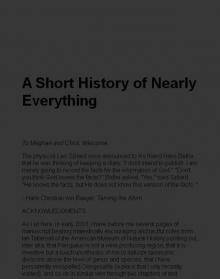 A Short History of Nearly Everything
A Short History of Nearly Everything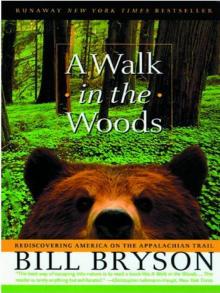 A Walk in the Woods
A Walk in the Woods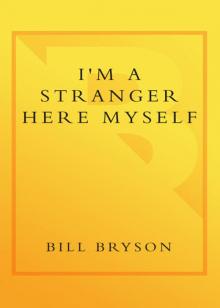 I'm a Stranger Here Myself
I'm a Stranger Here Myself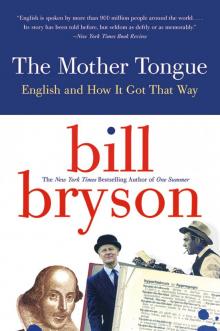 The Mother Tongue
The Mother Tongue Shakespeare
Shakespeare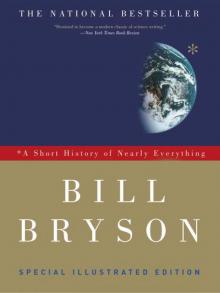 A Short History of Nearly Everything: Special Illustrated Edition
A Short History of Nearly Everything: Special Illustrated Edition The Best American Travel Writing 2016
The Best American Travel Writing 2016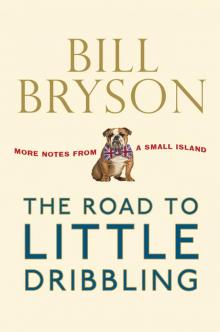 The Road to Little Dribbling
The Road to Little Dribbling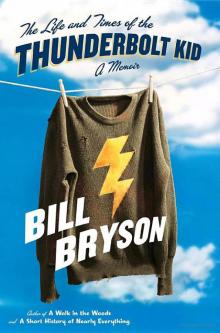 The Life And Times Of The Thunderbolt Kid: A Memoir (v5.0)
The Life And Times Of The Thunderbolt Kid: A Memoir (v5.0) Made In America
Made In America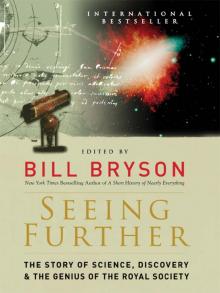 Seeing Further
Seeing Further Shakespeare: The World as Stage
Shakespeare: The World as Stage The Life and Times of the Thunderbolt Kid
The Life and Times of the Thunderbolt Kid At Home
At Home Bryson's Dictionary For Writers And Editors (v5.0)
Bryson's Dictionary For Writers And Editors (v5.0) Neither Here Nor There
Neither Here Nor There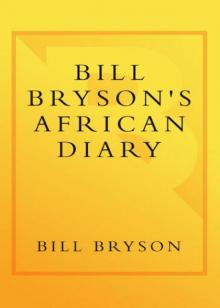 Bill Bryson's African Diary
Bill Bryson's African Diary